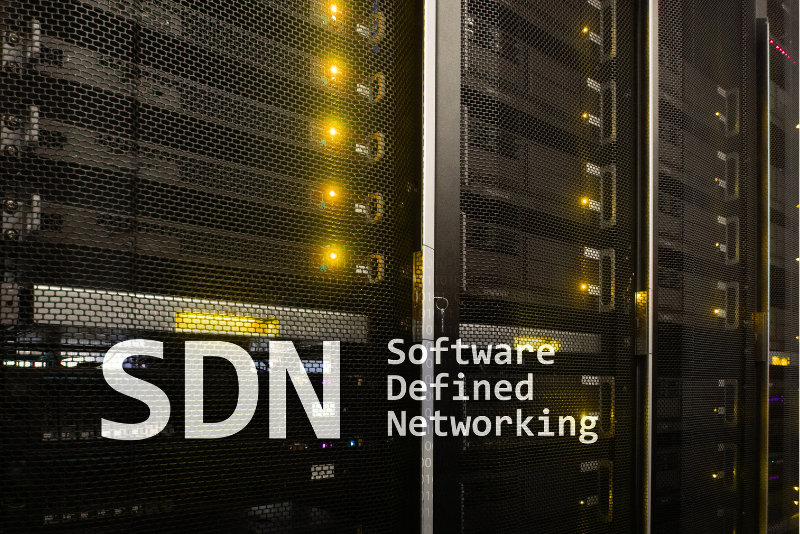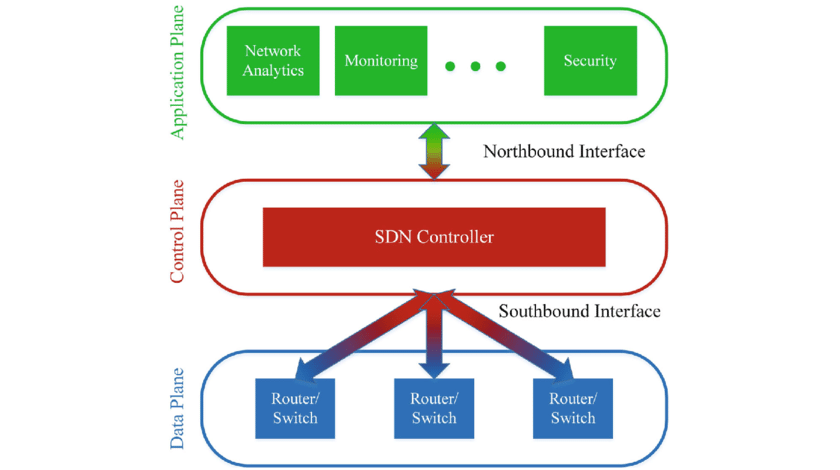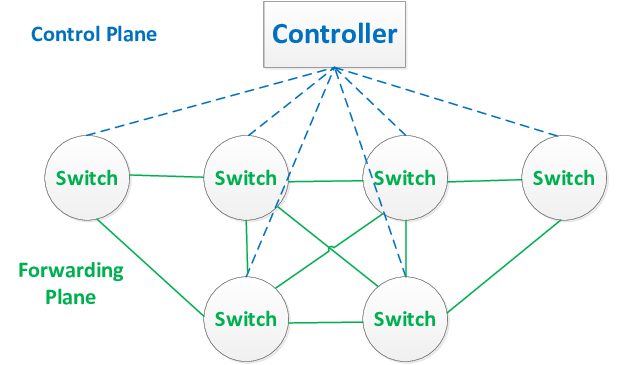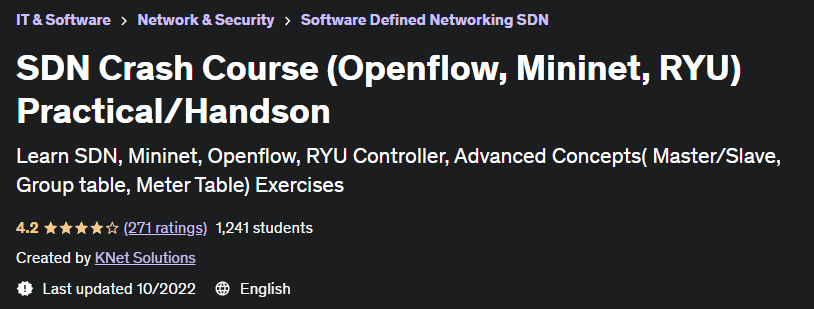The growth of multimedia content, the increasing use of mobile devices, and the demand for cloud computing have all contributed to the need for more flexible and efficient networking architectures. As these trends have led to unpredictable traffic patterns and sudden increases in demand for particular resources, traditional networking architectures have struggled to keep up. There was a need for an alternative strategy because scaling network infrastructure to handle these fluctuations can be very costly and complicated. SDN was developed to solve this problem by separating the control plane from the data plane. This enables the network to reconfigure itself automatically to meet changing demands, improving its overall performance and efficiency. Let’s understand what this SDN is all about.
What is SDN?
Software-defined networking (SDN) is a modern networking architecture that allows administrators to use software to define and control the behavior of network devices rather than configuring those devices individually. It is often paired with network function virtualization (NFV) further to improve the flexibility and cost-effectiveness of the network. Also, it allows for the centralization of network intelligence, making it easier to troubleshoot and monitor the network.
Architecture of SDN
An SDN architecture typically includes three main layers: application plane, control plane, and data plane. The Northbound and Southbound interfaces are used to facilitate communication between the different layers of the architecture. Integrating these three layers allows the network to operate in a coordinated and efficient manner.
How SDN works?
In an SDN network, the control plane and the data plane are separated. The control plane makes decisions about how traffic is forwarded through the network, while the data plane is responsible for forwarding traffic according to those decisions. The control plane is implemented using a central controller, a software application that runs on a single server or a set of servers. The controller maintains a global view of the network and uses this view to make decisions about how traffic should be forwarded. It does this by communicating with the data plane elements in the network, which are known as “forwarding elements” or “switches.” These switches in an SDN network are typically “open,” meaning they can be controlled and programmed by external software rather than being hard-coded with a fixed set of rules for forwarding traffic. As a result, the controller can configure the switches to transmit traffic in the desired manner. To control the switches, the controller communicates with them using a southbound API, a set of protocols and interfaces that the controller can use to send instructions to the switches and receive status information from them. And the controller uses northbound APIs to communicate with higher-level applications and systems that need to use the network, such as applications running in the cloud. In this way, the controller acts as the “brain” of the network by making decisions about how traffic should be forwarded and communicating those decisions to the switches, which act as a “muscle” of the network, carrying out the instructions received from the controller and forwarding traffic accordingly.
Features of SDN
There are several key features of SDN that distinguish it from traditional networking architectures:
Flexibility: Changes to the network can be made without physically reconfiguring devices which allows network managers to react swiftly to evolving requirements and circumstances. Programmability: It is possible to programmatically control the behavior of the network using APIs or other software development tools. This makes it easier to automate network tasks and integrate the network with other systems. Abstraction: In an SDN architecture, the control plane is separated from the data plane, which forwards the traffic. This helps engineers easily change how the network operates without affecting the forwarding traffic devices. Virtualization: It also allows for the virtualization of networking resources, allowing administrators to create virtual networks on demand. This can be particularly useful in cloud computing environments where the demand for networking resources can be highly dynamic.
In addition to the features listed above, the primary advantage of using SDN is that it enables businesses to simulate their physical networking infrastructure in software, thereby lowering overall capital expenses (CAPEX) and operating expenses (OPEX).
Types of SDN Architectures
In general, different types of networks may require different approaches to SDN. For example, a large enterprise network with many different types of devices and a complex topology may benefit from a hybrid SDN architecture, which combines elements of both centralized and distributed SDN. Conversely, a centralized SDN design might work well for a smaller network with fewer devices and a simpler topology. It is important to carefully evaluate the different options and choose the architecture that best meets the needs of the organization. SDN primarily uses five different architecture models.
#1. Centralized SDN
In a centralized SDN architecture, all control and management functions are consolidated into a single central controller, which allows administrators to define and control the behavior of the network easily. Still, it can also create a single point of failure.
#2. Distributed SDN
In this architecture type, the control functions are distributed among multiple controllers, improving reliability but making it more complex to manage the network.
#3. Hybrid SDN
Hybrid SDN architecture model combines centralized and distributed SDN elements. It may use a centralized controller for some functions and distributed controllers for others, depending on the needs of the network.
#4. Overlay SDN
Overlay architectures use virtual networking technologies, such as VXLAN or NVGRE, to create a logical network on top of an existing physical network. This allows administrators to create virtual networks that can be easily created, modified, and deleted.
#5. Underlay SDN
Underlay architecture utilizes the existing network infrastructure to support the creation of virtual networks that may use technologies such as MPLS or segment routing to create virtual links between devices in the network.
Learning Resources
It can be challenging to choose the best resources for learning about SDN-related concepts, as there are many different options available. So, It might be helpful to try out a few different resources to see which works best for you.
#1. SDN Crash Course Practical/Hands-on
This is a course offered on the Udemy platform. This course is an excellent way of gaining hands-on experience in SDN and OpenFlow-based network programming. It also covers a variety of advanced OpenFlow concepts such as meter table (QoS) and group table (Load balancer, Sniffer). We would highly recommend this course to anyone looking to learn more about SDN and the different technologies involved. Just basic networking knowledge is enough to get started with this course.
#2. SDN: Software-Defined Networks
This book primarily discusses SDN’s key technologies and protocols, including OpenFlow, OpenStack, and ONOS. It provides detailed examples of how these technologies can be used to build and manage networks. It also provides helpful tips for setting up and managing SDN networks, including troubleshooting and security considerations.
#3. SDN and NFV Simplified
This book provides a comprehensive overview of SDN and NFV, including their benefits, technologies, and applications. It also includes real-world examples and case studies to help illustrate the key points and show how these technologies are being used in the industry. The authors did a great job of explaining the key concepts of SDN and NFV in a clear and concise way, making the book accessible to readers of all levels of technical expertise.
#4. Software-Defined Networks
This book offers a thorough introduction to SDN from the viewpoint of individuals implementing and utilizing the technology. This book is quite helpful for understanding the entire SDN architecture, even for beginners. It also discusses how the network is designed using industry standards for a scalable environment.
#5. SDN and NFV: Essentials
It is a well-written and engaging guide that provides a solid foundation in SDN and NFV and is suitable for readers of all levels of technical expertise. The best way to learn about SDN concepts is to get hands-on experience working with SDN tools and technologies. You can try setting up a simple SDN environment using tools such as Mininet and a controller like RYU and experiment with controlling network traffic using the software.
Wrapping Up
SDN is helpful in today’s digital environment because it makes networking more flexible and effective. In traditional networks, the control plane and data plane are tightly coupled, which means that changes to the control plane also require changes to the data plane. This can make it difficult and time-consuming to change the network, especially in large and complex networks. With SDN, the control plane is abstracted from the data plane, which makes it easier to control and optimize the behavior of the network programmatically. This can be especially useful in environments where there is a need to quickly and easily make changes to the network, such as in cloud computing environments where workloads can be rapidly provisioned and de-provisioned. I hope you found this article helpful in learning about SDN and its architecture. You may also be interested in learning about the best agentless network monitoring tools.

![]()





























